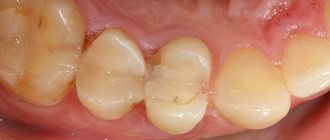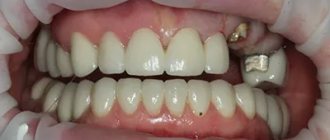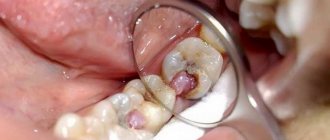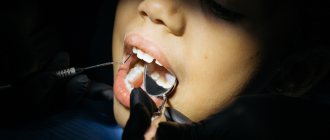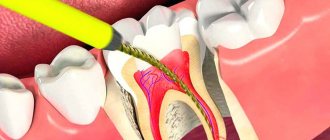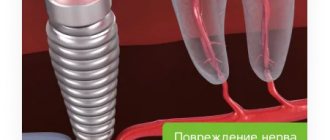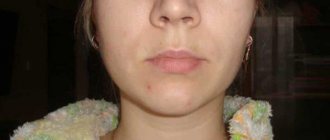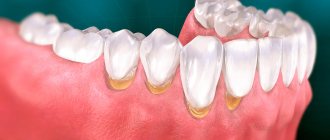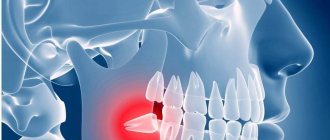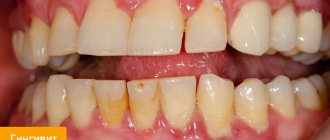From this article you will learn:
- whether wisdom teeth are treated or removed,
- indications and contraindications for treatment,
- Is it possible to remove a wisdom tooth - while it has not yet erupted.
Wisdom teeth are called eighth teeth - according to the serial number in the dental formula (counting is from the central incisors, respectively, for each half of the dentition of the upper and lower jaw). There are four wisdom teeth in total, and they always begin to erupt in the jaw later than all other teeth in the permanent dentition - usually between 18 and 21 years, although in some cases this can happen at 14 years, and even after 40 years. Is it necessary to remove wisdom teeth since they cause so many problems for most of their owners?
To remove or treat a wisdom tooth is determined in dentistry according to a number of criteria. For example, the most important of them is whether there is enough space in the dentition for their normal eruption. After all, for example, if the length of the lower jaw is insufficient, then the lack of space in the dentition will certainly cause their difficult eruption, accompanied by inflammation of the gums and pain. But that's not all, because... the constant pressure of a wisdom tooth trying to erupt on the 7th tooth in front is highly likely to lead to displacement of the teeth and the occurrence of crowding in the anterior sections of the dentition.
Eruption of wisdom teeth –
But very often the question: is it worth removing wisdom teeth - is asked in relation to already erupted, for example, partially destroyed eighth teeth. Whether such wisdom teeth are treated depends, for example, on the correct position of the tooth in the dentition, or on the presence of an antagonist tooth (with which the closure occurs), etc. Moreover, the opinion of dentists of different specializations may differ radically. For example, when you visit a dental surgeon, the doctor may immediately recommend that you remove it, just so as not to sit idle. The same applies to dental therapists.
It is best for the decision on the need to remove or treat a wisdom tooth to be made by an orthopedic dentist (prosthetist), because the most important thing is to make this decision precisely from the point of view of the need for this tooth for prosthetics in the future. As for the issue of removing figure eights if their eruption is difficult, it is advisable that such a decision be made by an orthodontist. Because, again, when you have an appointment with a dental surgeon, often such doctors do not even look at the length of the jaws, but immediately recommend removing the eights, although they could have erupted quite normally.
Content
- Reasons for the development of pathology
- Which doctor should I contact if my tooth has chipped?
- Activities before visiting the dentist
- Microprosthetics
- Place a crown on a chipped tooth
- When is implantation necessary?
Tooth decay is an unpleasant event that requires immediate response. This can happen due to injury, untreated caries, brittle teeth and other reasons. Any chips, even small ones, mean a violation of the integrity of the enamel. That is, the tooth becomes vulnerable, infection can enter and the destruction of the crown part can continue. The patient begins to feel discomfort and pain when exposed to hot and cold temperatures, sweet and sour. The sharp edge of the chip injures the soft tissue of the gums during chewing, and bacteria penetrating into the wound cause inflammation. To restore your tooth and avoid negative consequences, you should immediately make an appointment with a specialist.
Symptoms of a tooth fracture
Injuries often go unnoticed, as a result of which the floor of a tooth that is deprived of sensitivity is broken. Also, the clinic may be absent if there is minor damage to the enamel. Such defects can only be determined visually during an independent examination of the oral cavity.
In other cases, when a tooth is fractured, a person experiences pain. A pain syndrome that limits the movement of the lower jaw occurs when a tooth breaks at the root, and the fragments injure the soft tissue of the gums. A tooth broken under the gum often causes loosening of adjacent units, bleeding and speech impairment.
Deputy Chief physician Sergey Evgenievich Brodsky
Sign up for a free consultation
+7
First aid for a fracture
When a tooth breaks and hurts, you should immediately seek help from a dentist. Before examination by a specialist, doctors at the Partner-Med clinic recommend providing first aid, namely:
- rinse your mouth with clean boiled water at room temperature or warm chamomile infusion;
- apply and firmly clamp the application with cotton wool or a bandage in case of bleeding;
- take a pain reliever with an anti-inflammatory effect (Analgin, Paracetamol, Ibuprofen) if there is severe pain;
- apply a cold compress to the sore spot;
- immobilize the jaw with a tight bandage if injury is suspected.
Complications
If the front upper or lower teeth are broken, this causes, first of all, aesthetic discomfort, as the smile changes, articulation and clarity of diction are impaired. It can often provoke the development of psychological problems and complexes. A broken chewing tooth disrupts the food processing process. Large particles of food entering the stomach lead to disruption of its functions. The development of pathological processes is accompanied by a feeling of discomfort in the abdominal area and heartburn. A broken tooth under the crown causes displacement of the prosthesis, deformation of adjacent units, or injury to the gums. There is also a danger of developing infectious and inflammatory processes as a result of the penetration of pathogenic flora into injured tooth and gum tissues.
Ask a question!
8
We'll call you back in 1 minute
Diagnostics
After visiting a dental clinic, a specialist relieves pain and conducts a visual examination of the oral cavity, during which it is possible to determine:
- degree of damage to hard dental tissues;
- dislocation of adjacent teeth;
- tissue necrosis;
- penetration of blood into the tooth cavity.
To obtain a complete clinical picture, assess the condition of the roots of a broken tooth, the degree of displacement and damage to the nerve fibers, an x-ray examination is performed. In case of severe injuries, an orthopantogram or electroodontometry is performed to determine the condition of the dental system and assess the viability of the pulp.
Reasons for the development of pathology
Damage can be caused by several direct or indirect factors. Determining the cause is an important aspect for proper treatment. Among these factors:
- Mechanical damage due to trauma.
- Chipping due to bad habits (biting nails, pens, and other objects not intended for this purpose).
- Reduced acidity of the oral cavity, which negatively affects the strength of enamel.
- Bite defects.
- Dental pathologies that have not received treatment.
- Remineralized enamel.
- Hormonal imbalances, changes during pregnancy.
- Frequent consumption of excessively hot or cold foods.
- Night grinding of teeth.
Reasons why a tooth may chip
- When teeth are injured, they often chip.
- The immune system affects the strength of tooth enamel.
- There is an imbalance in the hormonal system in the body.
- Eating hard and unhealthy foods can lead to chipped teeth.
- An incorrect bite can cause damage to the integrity of the teeth.
- Tooth enamel is in the stage of demineralization.
- Presence of a crack in the tooth.
Poor bite is one of the most common causes of chipped teeth. When chewing food, the teeth of the lower and upper jaw injure each other and cause chipping. Nighttime teeth grinding can also cause chipped teeth.
Bad habits (smoking, alcohol) thin the enamel of teeth, on which cracks may appear that turn into chips. An imbalance in the acid-base balance in the mouth also thins the enamel, which becomes fragile and breaks easily.
Chronic diabetes mellitus causes hormonal imbalance, which affects dental health.
Activities before visiting the dentist
Depending on the extent of the damage, the patient may feel discomfort from increased sensitivity and pain. If a sharp edge is formed after the chipping, it will scratch the gum, tongue, and cheek. Such damage is a favorable environment for infection. The sharp edge must be isolated as soon as possible. A tooth that has lost full enamel protection is also vulnerable to infection.
While waiting for a visit to the dentist, the patient can take a number of actions to minimize negative consequences:
- Do not put any pressure on the affected tooth or chew hard food on its side.
- Thoroughly clean the chipped area, avoiding the accumulation of food debris and plaque.
- Rinse with a soda solution (you can add iodine and salt).
- If your chipped tooth hurts, you can take a pain reliever.
PROMOTION
Hygienic teeth cleaning
2000 rub.
Causes of caries
The main reason for the appearance of caries in wisdom teeth is their location. The third molars erupt last and at the very end of the dentition. The distant location greatly complicates the process of daily brushing of teeth. If the lower eights are visually accessible and if the cleaning with a toothbrush is poor, the procedure can be repeated, then the upper molars remain in a “blind” and hard-to-reach area.
Bacterial plaque, which gradually accumulates on the walls of the tooth, begins to destroy the enamel. Due to the absence of signs of damage at the initial stage and poor visibility of the tooth itself, the carious process progresses and penetrates deeper. As a rule, people turn to the dentist already at the stage of deep caries or pulpitis.
The cause of wisdom teeth caries can also be:
- carious lesion of the adjacent tooth;
- caries of the opposite eight.
Impacted, that is, partially erupted figure eights, are also often affected by caries, despite the fact that they are partially hidden by the gum. With insufficient hygiene, food particles and bacterial deposits penetrate under the gingival hood. As a result, the process of tissue destruction begins.
Microprosthetics for tooth restoration
To restore the aesthetics and full function of a damaged tooth, restoration is used. If the chip is small, the problem can be solved using composite materials. For more significant damage, microprosthetics would be an excellent option. Inlays, which serve as microprostheses for restoring teeth, are made from composite materials based on an impression. They are durable and aesthetic, and are widely used in modern dentistry.
Micro-prostheses also include veneers. These are thin plates that are attached from the outside to the prepared teeth (in the frontal zone of the dentition, covering the front part and lower edge of the tooth). Veneers are also made from impressions and are effective in correcting most aesthetic problems. The plates are mainly made of ceramics and zirconium dioxide.
If the injury affects the pulp, the specialist treats the canals, and then fills or installs a microprosthesis.
Wisdom teeth diseases
Most often, third molars suffer from caries, since due to the inconvenient location of the “eights” in the mouth, it is extremely difficult to take good care of their hygiene. A carious cavity usually occurs in an area that is difficult for the dentist to reach, so treatment is not always possible. If the doctor understands that it will not be possible to get close to the affected area and fill the tooth properly, he suggests removing the third molar.
At the same time, it is important to understand that you should not delay going to a specialist if you notice any problems with the G8. Untreated caries may well develop into pulpitis and even periodontitis, which will require a definitive tooth extraction.
Installing a crown on a chipped tooth
In case of significant injuries, if it is impossible to restore the crown part of the tooth, a new tooth can be obtained using prosthetics. The prosthesis - crown - is fixed on the root of the tooth if this part remains healthy and strong. Different types of crowns are used depending on the material of manufacture:
- Metal ceramics are the most inexpensive option. The design is durable due to the metal base, and aesthetic due to the ceramic layer. Such dentures become an ideal option for budget restoration of teeth in the chewing area. Installation of metal ceramics in the frontal area is possible, but the tooth will not look natural due to the lack of transparency.
- Zirconium dioxide is a modern high-tech material that has both the strength and aesthetics of natural teeth. Such crowns are made using computerized technology and are practically indistinguishable from natural teeth in appearance. They refract light correctly and have a certain degree of transparency, similar to tooth enamel.
- Ceramic crown. This option is only suitable for the front teeth, since the structure is not strong enough to withstand the full chewing load. Ceramics look very aesthetically pleasing.
How to restore a broken tooth?
What to do if a tooth is broken in half vertically?
If the wall of a tooth is broken, the dentist tries to save one of the roots if there is a fracture of a molar that has several processes. To do this, root canal treatment is performed and removal of the appendage, which cannot be saved. Next, a crown is installed in place of the broken tooth wall.
What to do if a tooth is half broken?
If a tooth is broken in half and the chip is horizontal, the doctor evaluates the condition of the tooth and root system. A broken tooth can be repaired using composite resin for minor chips or removed for significant decay. After removing the unit, the dentist prescribes an implantation procedure with the installation of a pin.
What to do if a tooth breaks but the root remains?
If a tooth is broken and the root remains in the gum, based on x-ray data, a decision is made to preserve or remove the root.
When removing the root, the dentist offers two options for restoring the unit:
- dental implantation with the installation of a titanium pin;
- installation of adhesive bridges under a broken tooth with micro-locks on the back walls of supporting teeth.
If the size of the preserved stump is at least 3 mm, and the thickness of the remaining tooth walls is at least 1 mm, restoration is carried out using:
- filling and covering with a crown to restore the anatomical structure;
- restorations by implanting a fiberglass pin, filling and installing a crown;
- stump inlay covered with a crown.
What can you do if your front tooth is broken?
If the front tooth is broken in half, in the presence of a base, the doctor performs a build-up that will not only restore the functionality of the unit, but also restore the aesthetic appearance of the smile.
This restoration method is only possible when the broken front tooth is not affected by caries. In other cases, prosthetics are prescribed. Ask us your question DIRECTLY!
+7
DECIDE! They will definitely help you here!
What to do if your front tooth is broken at the root?
If a front tooth is broken at the root, the dentist always uses the most gentle techniques possible and tries to save the tooth if possible.
When is a tooth and root removed?
A broken wisdom tooth and a broken back tooth that is not involved in chewing processes are subject to removal. Doctors recommend removing a broken tooth if part of the hard tissue and root system is damaged, there are pronounced putrefactive processes and there is no possibility of restoring the tooth. The root subject to inflammatory and putrefactive processes, as well as the broken root of the front and chewing tooth, which cannot be restored, must be removed. The procedure is carried out using ultrasound after opening the gums. In difficult cases, the root is divided into several parts and then removed. After removing the broken tooth, a crown is installed.
Prevention
To prevent tooth fracture, specialists at the Partner-Med dental clinic recommend following the following prevention methods:
- undergo an annual dental examination;
- promptly treat caries and other dental diseases;
- Healthy food;
- replenish calcium deficiency with a course of vitamin-mineral complex;
- brush your teeth twice a day;
- After eating baked goods and sweets, rinse your mouth with clean water.
A broken tooth is a problem that anyone can face. Dentists at the Partner-Med clinic will help you choose the most gentle option for treating and restoring a broken tooth.
Request a call back or dial our number!
+7
This phone call does not obligate you to anything. Just give us a chance and we will help you!
Just pick up the phone and call us!
+7
We will definitely make you an offer that you cannot refuse!
When is implantation needed?
Implantation is required if the root part of the tooth is damaged and cannot be used as a support for a prosthesis. This can happen when the side wall of the tooth is broken (below the gum level), deeply damaged by caries, root fracture, etc. In these cases, the tooth is completely removed and replaced with a titanium rod - an implant. Crowns are also placed on implants. These are metal ceramics and zirconium dioxide; ceramic prostheses are not used due to their high fragility.
Generalized scheme for tooth extraction
The process of removing any tooth includes the following steps:
- Examination and collection of anamnesis (allergic status, information about the state of health and the dental apparatus).
- Preparation of the surgical field: treatment of the injection site, rinsing the mouth with an antiseptic.
- Anesthesia.
- Detachment of gum from tooth using a trowel.
- Loosening a tooth with forceps.
- Extracting a tooth from its socket.
- Treating the hole with an antiseptic.
- Stop bleeding with tamponade.
According to this scheme, simple removal is carried out. In some situations, for example, when a wisdom tooth or a badly damaged molar is pulled out, a complex extraction is required. Its main difference is that in addition to forceps, the dentist uses a drill to cut out bone tissue or saw the root into pieces, a chisel, a hammer and other dental instruments.
Wisdom tooth removal diagram
Getting rid of a wisdom tooth can be especially difficult. Due to its location in the posterior quadrant of the jaw, access to it is difficult. With anatomically incorrect or curved roots, which are often found in third molars, the dentist may be forced to make incisions in the gums, pull out the root piece by piece, and then apply sutures.
Prevention of dental diseases
A number of simple steps will help the patient keep his teeth healthy for as long as possible and reduce the likelihood of diseases:
- Careful hygiene, brushing teeth at least twice a day.
- Using dental floss and rinsing with special solutions.
- Attention to the condition of soft tissues and gums.
- Timely visit to the dentist if alarming symptoms appear, preventive examinations twice a year.
How to pull a tooth at home without pain
How to relieve toothache at home
What complications can there be?
The gradual destruction of the figure eight inevitably leads to the development of inflammatory processes, because a crown with large chips quickly becomes a breeding ground for harmful bacteria. In this case, the damage rapidly spreads deep into the hard tissues, moving to dentin and pulp. This situation is fraught with the appearance of acute symptoms: severe pain and the onset of suppuration processes. Urgent removal of the causative element is required, but such conditions significantly complicate the doctor’s task. If the cause is caries, the pathology can easily spread to the adjacent molar and lead to its destruction.
Removal steps
The dentist removes the “figure eight” using the following technology:
- First, the doctor administers local anesthesia;
- The mucous membrane and periosteum are removed;
- A section of bone above the diseased tooth is cut out;
- The tooth is removed. In some particularly difficult cases, removal is carried out in parts;
- The periosteum, like the mucous membrane, is sutured;
- The hole is cleaned with an antiseptic and a tampon is placed.
Gradually, a bloody clot forms in the hole, protecting the wound from infection.
Myth six: after filling, do not eat for 2 hours
The recommendation to limit food intake after a filling procedure is still stable. Moreover, people often give it to themselves. “Before, the doctor put a filling and said that you need to not eat for 2 hours. Now this limitation is only due to the fact that we use anesthesia during treatment. After this, the patient does not feel part of his cheek and lip. By starting to chew in this state, the patient runs the risk of biting himself. That’s why I always say that you can eat as soon as the anesthesia wears off,” says Ilya Antonov.
Indications for removal
In some circumstances, removing the “eight” becomes the only way out. In particular, the doctor will decide to get rid of the eighth tooth if:
- It is located at an angle and when cutting through it puts pressure on the roots of its neighbors;
- A partially erupted tooth injures the gums;
- When affected by caries, the treatment area is difficult to reach;
- The roots of the "eight" grow in the maxillary sinus;
- The patient suffers from facial neuralgia;
- Complications developed;
- There is a gum cyst in the eruption area.

